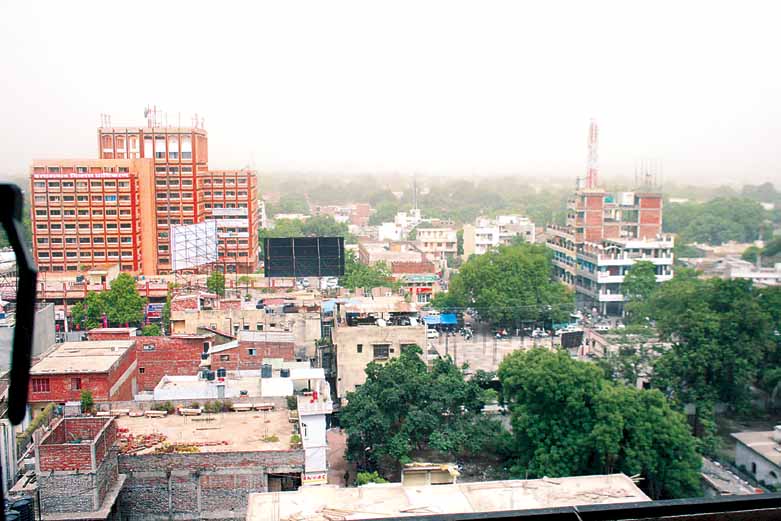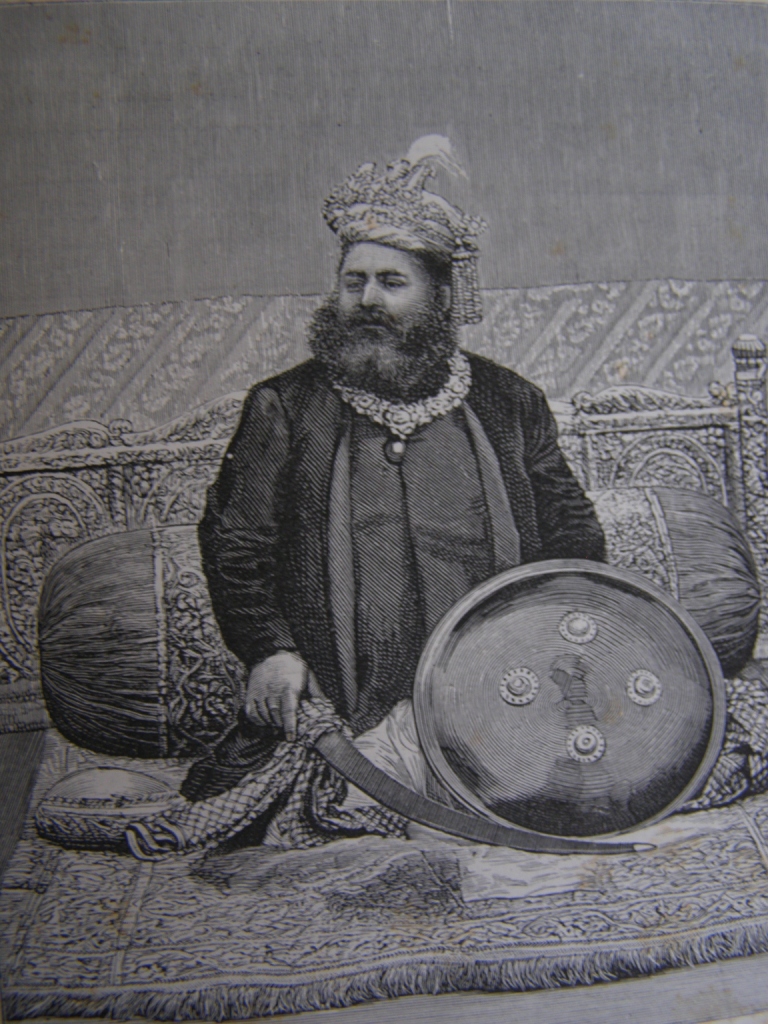|
Darbhanga, Prayagraj
Darbhanga Colony (formerly known as Darbhanga Castle or Lowther Estate) is a posh central neighborhood in Prayagraj, India. It was formerly owned by the Royal family of Darbhanga. It still houses the Lowther Castle in the colony. Darbhanga Colony played important a role in Independence movement of India as the Fourth and Eighth annual convention of Indian National Congress was held in here. Location With its central location in the city it as bordered by Georgetown. Other locations in Prayagraj are at optimum distance from it such as the Civil Lines, Colonelgunj, Rambagh, etc. Culture Durga Puja celebrations organized by the Darbhanga Colony Puja Committee is one of the best organized events in Prayagraj attracting lakhs of devotees. Darbhanga Castle Darbhanga Castle (also known as Lowther Castle) was the residential building of the then Maharaja of Darbhanga The Darbhanga Raj, also known as Raj Darbhanga and the Khandwala dynasty, was a Maithil Brahmins dynasty and ... [...More Info...] [...Related Items...] OR: [Wikipedia] [Google] [Baidu] |
Neighbourhoods Of Prayagraj
The Old Prayagraj City, at the south of Prayagraj Junction Railway Station, consists of neighborhoods like Chowk, Johnstongunj, Dariyabad, Khuldabad etc. and was in existence from the time of Akbar. Some magnificent structures erected in this era consist of the Khusro Bagh and the Allahabad Fort. In the north of Railway Station, the New Prayagraj City consists of neighborhoods like Lukergunj, Civil Lines, Georgetown, Tagoretown, Bharadwaj Puram, Ashok Nagar, Mumfordgunj etc., which are relatively new and were built during the British rule. These neighborhoods reflect British architecture like the All Saints Cathedral, Alfred Park and Allahabad High Court. Newer residential areas include neighborhoods like Kareli and suburbs like Naini Jhunsi and Manauri bajar. Allengunj Area close to Prayag Junction, has staff selection board office there, lots of women hostels there. Alopibagh Alopibagh is a locality/township of Prayagraj, Uttar Pradesh, India. The locality is cl ... [...More Info...] [...Related Items...] OR: [Wikipedia] [Google] [Baidu] |
Prayagraj
Allahabad (), officially known as Prayagraj, also known as Ilahabad, is a metropolis in the Indian state of Uttar Pradesh.The other five cities were: Agra, Kanpur (Cawnpore), Lucknow, Meerut, and Varanasi (Benares). It is the administrative headquarters of the Allahabad district—the most populous district in the state and 13th most populous district in India—and the Allahabad division. The city is the judicial capital of Uttar Pradesh with the Allahabad High Court being the highest judicial body in the state. As of 2011, Allahabad is the seventh most populous city in the state, thirteenth in Northern India and thirty-sixth in India, with an estimated population of 1.53 million in the city. In 2011 it was ranked the world's 40th fastest-growing city. Allahabad, in 2016, was also ranked the third most liveable urban agglomeration in the state (after Noida and Lucknow) and sixteenth in the country. Hindi is the most widely spoken language in the city. Allahabad li ... [...More Info...] [...Related Items...] OR: [Wikipedia] [Google] [Baidu] |
Uttar Pradesh
Uttar Pradesh (; , 'Northern Province') is a state in northern India. With over 200 million inhabitants, it is the most populated state in India as well as the most populous country subdivision in the world. It was established in 1950 after India had become a republic. It was a successor to the United Provinces (UP) during the period of the Dominion of India (1947–1950), which in turn was a successor to the United Provinces (UP) established in 1935, and eventually of the United Provinces of Agra and Oudh established in 1902 during the British Raj. The state is divided into 18 divisions and 75 districts, with the state capital being Lucknow, and Prayagraj serving as the judicial capital. On 9 November 2000, a new state, Uttaranchal (now Uttarakhand), was created from Uttar Pradesh's western Himalayan hill region. The two major rivers of the state, the Ganges and its tributary Yamuna, meet at the Triveni Sangam in Prayagraj, a Hindu pilgrimage site. Ot ... [...More Info...] [...Related Items...] OR: [Wikipedia] [Google] [Baidu] |
India
India, officially the Republic of India (Hindi: ), is a country in South Asia. It is the seventh-largest country by area, the second-most populous country, and the most populous democracy in the world. Bounded by the Indian Ocean on the south, the Arabian Sea on the southwest, and the Bay of Bengal on the southeast, it shares land borders with Pakistan to the west; China, Nepal, and Bhutan to the north; and Bangladesh and Myanmar to the east. In the Indian Ocean, India is in the vicinity of Sri Lanka and the Maldives; its Andaman and Nicobar Islands share a maritime border with Thailand, Myanmar, and Indonesia. Modern humans arrived on the Indian subcontinent from Africa no later than 55,000 years ago., "Y-Chromosome and Mt-DNA data support the colonization of South Asia by modern humans originating in Africa. ... Coalescence dates for most non-European populations average to between 73–55 ka.", "Modern human beings—''Homo sapiens''—originated in Africa. Then, int ... [...More Info...] [...Related Items...] OR: [Wikipedia] [Google] [Baidu] |
Darbhanga
Darbhanga is the fifth-largest city and municipal corporation in the Indian state of Bihar situated centrally in Mithila region. Darbhanga is the headquarters of the Darbhanga district and the Darbhanga division. It was the seat of the erstwhile Khandwala Zamidaar dynasty Under Mughals. It was the capital of Mithila. It is considered the Medical Capital of North bihar. It has DMCH & second AIIMS Hospital in the State Only after Capital Patna. Darbhanga is one of the oldest cities in India. Musical, folk art, and literary traditions in Sanskrit, Maithili and Urdu have been passed down generations in Darbhanga and constitute the city's strong cultural background. History The city was the capital of the Darbhanga Raj, an estate established in the 16th century, and contains the Anandbagh Palace. It was constituted a municipality in 1864. Darbhanga is home to the Kameshwara Singh Darbhanga Sanskrit University (1961), which is located on the grounds of the palace, and the Lal ... [...More Info...] [...Related Items...] OR: [Wikipedia] [Google] [Baidu] |
Georgetown, Prayagraj
George Town is an upper-class neighbourhood locality in Prayagraj, India. Built in 1901, it is a residential area in the central part of the city mainly occupied by the white collar workers. It also houses a large number of hospitals and clinics. Georgetown is famous for is affluent surroundings and apartments. It is bordered by Kamla Nehru Road in the west, Thornhill Road, MG Marg in the south and Tagoretown in the west. Park Road, Lowther Road and Hamilton Road runs through the neighborhood. Notable landmarks located in and near the neighborhood are Chandrashekhar Azad Park Chandrashekhar Azad Park (also known by its former name Alfred Park, and Company Bagh during the Company Raj) is a public park in Prayagraj, Uttar Pradesh, India. Built in 1870 to mark Prince Alfred's visit to the city, with an area of 133 ... and Darbhanga, Prayagraj. References Neighbourhoods in Allahabad {{Allahabad-geo-stub ... [...More Info...] [...Related Items...] OR: [Wikipedia] [Google] [Baidu] |
Civil Lines, Prayagraj
Civil Lines (formerly Cannington also Canning Town) is a Civil Lines neighborhood of Prayagraj, Uttar Pradesh, India. It is the upper-class central business district of the city and is famous for its urban setting, gridiron plan roads high rise buildings, offices, cafes, restaurants, hotels, malls, shopping complexes, theatres etc. Built in 1857, under the supervision of Cuthbert Bensley Thornhill, it was the largest town-planning project carried out in India before the establishment of New Delhi. History Civil Lines was built in 1858 a few months after the end of the Rebellion of 1857, when around 600 Meo people were massacred by the British people in India for their alliance with the Indian Independence Movement activists and eight villages were seized to form a new township. During the early period of its development it was referred to as the White Town of the city as it was predominated by the British people and a very few Indians Indian or Indians may refer to: ... [...More Info...] [...Related Items...] OR: [Wikipedia] [Google] [Baidu] |
Colonelgunj
Allahabad (), officially known as Prayagraj, also known as Ilahabad, is a metropolis in the Indian state of Uttar Pradesh.The other five cities were: Agra, Kanpur (Cawnpore), Lucknow, Meerut, and Varanasi (Benares). It is the administrative headquarters of the Allahabad district—the most populous district in the state and 13th most populous district in India—and the Allahabad division. The city is the judicial capital of Uttar Pradesh with the Allahabad High Court being the highest judicial body in the state. As of 2011, Allahabad is the seventh most populous city in the state, thirteenth in Northern India and thirty-sixth in India, with an estimated population of 1.53 million in the city. In 2011 it was ranked the world's 40th fastest-growing city. Allahabad, in 2016, was also ranked the third most liveable urban agglomeration in the state (after Noida and Lucknow) and sixteenth in the country. Hindi is the most widely spoken language in the city. Allahaba ... [...More Info...] [...Related Items...] OR: [Wikipedia] [Google] [Baidu] |
Rambagh, Prayagraj
Rambagh is a locality/township of Prayagraj, Uttar Pradesh Uttar Pradesh (; , 'Northern Province') is a state in northern India. With over 200 million inhabitants, it is the most populated state in India as well as the most populous country subdivision in the world. It was established in 1950 ..., India. Neighbourhoods in Allahabad Villages in Allahabad district {{Allahabad-geo-stub ... [...More Info...] [...Related Items...] OR: [Wikipedia] [Google] [Baidu] |
Maharaja Of Darbhanga
The Darbhanga Raj, also known as Raj Darbhanga and the Khandwala dynasty, was a Maithil Brahmins dynasty and the rulers of territories, not all contiguous, that were part of the Mithila region, now divided between India and Nepal. The rulers of Raj Darbhanga were Maithil Brahmins and their seat in the town of Darbhanga became the core of the Mithila region as the rulers were patrons of Maithil culture and the Maithili language. The dynasty emerged after the fall of the Oiniwar Dynasty. History The Khandaval dynasty was one of many Brahmin dynasties to rule in India, doing so in the Mithila/Tirhut region from the time of the Mughal emperor Akbar until the 1960s. They became known as the Raj Darbhanga. The extent of their lands, which were not contiguous, varied over time, and their area of ownership was smaller than the area that they were granted under sanad arrangements. A particularly significant reduction occurred when the influence of the British Raj caused them to l ... [...More Info...] [...Related Items...] OR: [Wikipedia] [Google] [Baidu] |
Lakshmeshwar Singh
Maharaja Sir Lakshmeshwar Singh, Maharaja of Darbhanga (25 September 1858 – 16 November 1898) was the Zamindar and principal landowner of Darbhanga in the Mithila region, presently in the State of Bihar, India. His philanthropic works, administrative abilities and management of his estate (Raj Darbhanga) were highly appreciated and lead to development of his estate. Biography Lakshmeshwar Singh was the eldest son of Maharaja Maheshwar Singh of Darbhanga, who died when Lakshmeshwar was aged two. The British Raj placed the estate of Darbhanga under the control of the Court of Wards because the heirs to the estate were minors. He was placed under the tutorship of Chester Macnaghten, who later served as the founding Principal of the oldest Public school in India, the Rajkumar College, Rajkot from 1870 to 1896. For the next 19 years, till he attained majority, he was caught in political one-upmanship between his mother, who was supported by family priests, and the Tutors appoin ... [...More Info...] [...Related Items...] OR: [Wikipedia] [Google] [Baidu] |






